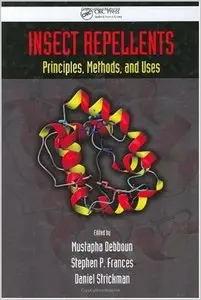Insect Repellents: Principles, Methods, and Uses by Mustapha Debboun
Publisher: CRC Press; 1 edition (October 25, 2006) | ISBN: 0849371961 | Pages: 495 | PDF | 9 MB
Publisher: CRC Press; 1 edition (October 25, 2006) | ISBN: 0849371961 | Pages: 495 | PDF | 9 MB
Drawing together information previously found only in articles, reviews, symposia proceedings, commercial literature, and medical entomology texts, Insect Repellents: Principles, Methods, and Uses is a one-volume source on the development, evaluation, and use of repellents. It provides a thoughtful analysis of old and new information, from the ancient history of people’s attempts to avoid bites, through the use of synthetic and botanical products, to pioneering techniques for development of repellent products. After reading this book, you will be able to perform the next step in research, thoroughly evaluate data on repellents, and choose the best products for any situation.
The editors introduce and define the word “phagomone” to fill the gap created by the many different meanings attributed to the word “repellent.” They present the history of repellent production that has led to the formulations currently in use and discuss the biological variety of phagomones as they function in nature. The book then delineates the methods used to assess the activity of phagomones and repellent products.
A special feature of the book is its coverage of what many consider the cutting-edge in repellent testing: automated tests of the arthropods’ responses, the use of computer models of chemistry, and the use of molecular biology methods. The book comprehensively compares active ingredients and includes an index of illustrated chemical structures that lists most chemicals involved in repellent development.
A thought-provoking discussion of the process of testing formulated products and comprehensive reviews of natural and synthetic active ingredients round out the book’s coverage. It supplies an in-depth understanding of the variety of purposes served by repellent bioassays and lays the foundation for evaluating data and designing new tests as well as developing and delivering new tools and approaches. This book provides all the information you need to give evidence-based recommendations.





